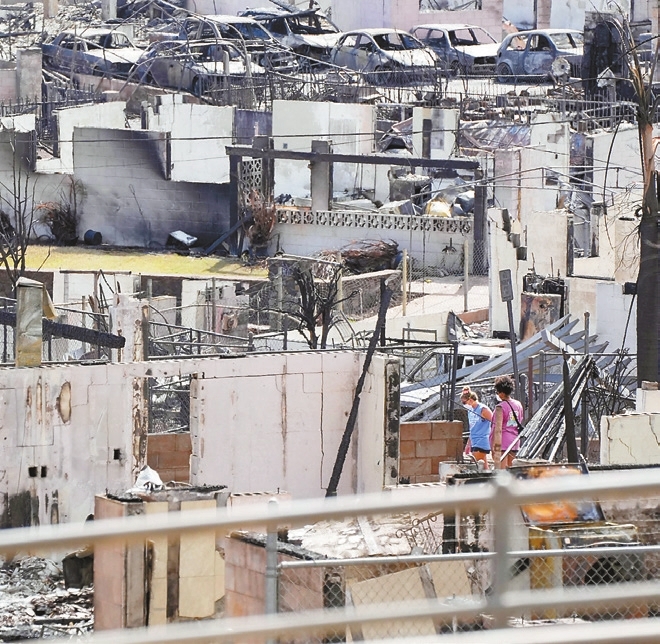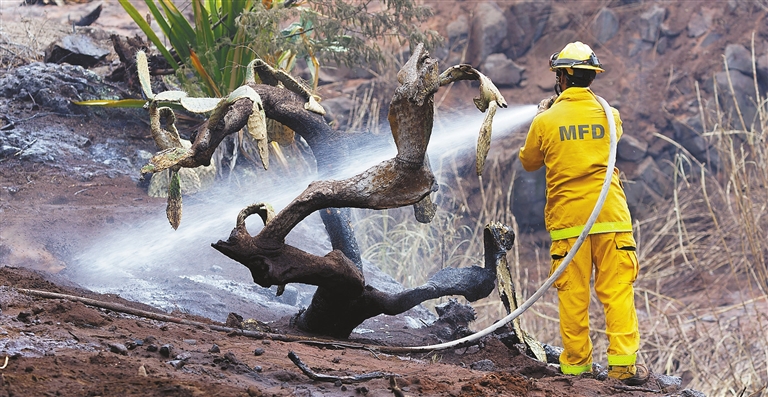

THE official death toll reached 99 in the wildfires on Maui as of Monday and is expected to increase “significantly” in the coming days, Hawaii Governor Josh Green said on TV news. The blaze that devastated the historic town of Lahaina is the deadliest U.S. wildfire in over 100 years, officials said. Maui County authorities will begin releasing the identities of those killed in the wildfires that swept across the island, police announced during a news conference Monday. Police and county officials will release the names of people whose families have been notified, Maui County Police Chief John Pelletier said. Meantime, crews continue to search areas impacted by the fires, he said. “To date, 25% of the area has been searched,” Pelletier said. Deadliest wildfires The death toll meant the disaster officially became deadlier than California’s Camp Fire in 2018, which killed 85 and became the deadliest fire in American history over the last 100 years. It also surpassed the state’s previous deadliest natural disaster, a 1960 tsunami that killed 61 people. An even deadlier tsunami in 1946, prior to Hawaii’s statehood, killed more than 150 on the Big Island. The U.S. Coast Guard in Maui has shifted its focus from search and rescue to containing potentially hazardous materials left behind by the fires. The agency said its first responders will shift resources to the fires’ maritime environmental fallout but will remain ready to respond to any new reports of individuals in the water. The shift in resources comes after the Coast Guard rescued at least 17 people last week who had fled into the ocean to escape the inferno that destroyed Maui’s Lahaina community. Thousands of people have been displaced, and more than 2,200 structures have been destroyed, showed the damage assessment released by the Pacific Disaster Center (PDC) and the Federal Emergency Management Agency (FEMA) early Saturday. The historic town of Lahaina, which was the capital of the Kingdom of Hawaii from 1820 to 1845, was burned down to the ground. One of the top attractions in Maui, Lahaina with over 12,000 residents was visited by 2 million travelers annually, accounting for approximately 80% of tourism on the second-largest Hawaiian island. “Without a doubt, it feels like a bomb was dropped on Lahaina,” Green said Friday after walking the ruins of the town with the mayor. In a video posted online, Milo Tomkinson, 13, and his big brother, Noah Tomkinson, 19, recalled their terrible experience when they tried to escape the town with their mom as flames spread from one block to another with incredible speed. They were at their Lahaina home when they noticed the flames getting closer, so they tried to flee in their car, but the only road was jammed by panic people. They immediately decided to leave their car behind and tried looking for shelter on foot, but flames were everywhere. At last they found the only route to survive: the Pacific. “This is the last resort, because the fire was across the street at this point,” Noah said. “So we’ve got to jump in the ocean ... and then, once we got in the water, all the wind and all the fire, and the smog are coming straight toward us.” They waded in chest-to-shoulder-deep water for five hours before the flames began to die down and the sky turned dark. While the cause of the fire has not been determined, observers have pointed to downed power lines, sputtering fire hydrants, and emergency alarms that sat silent as factors that hampered the response to the deadly blaze. As the fires grew last Tuesday, they were buffeted by extreme winds caused by Hurricane Dora, which was passing hundreds of miles south of Maui. Those winds also battered power lines on the island, and dramatic videos show lines swaying and being toppled in the gusts. Even before the winds from Hurricane Dora fed the flames on Maui, a dangerous combination of drought and dry grasses set the stage for the disaster by transforming the island into a tinderbox. Like large swaths of the mainland United States, Hawaii is in the midst of a drought, with parts of Maui suffering from severe drought conditions. This has become more extreme and common across the archipelago and others like it in the Pacific, according to the U.S. National Climate Assessment released in 2018. Failed alarm system Despite the bad weather, questions have been raised about Hawaii’s siren system, as many survivors told the media that they received no official warnings about the blaze when the tragedy came and only realized they were in danger when they saw flames or heard explosions nearby. The Hawaii Emergency Services Administration said Friday that the warning sirens were not activated on Maui during the wildfire incident, but alerts were sent by mobile devices, radio and television, and the opt-in resident alert system. Maui Fire Department Chief Brad Ventura said the fire moved so quickly from brush to neighborhoods that it was impossible to get messages to the emergency management agency. But Elizabeth Pickett, co-executive director of the Hawaii Wildfire Management Organization, told the Honolulu Civil Beat that the tragedy was foreseeable. She said a report that she co-authored nearly a decade ago identified an increased wildfire risk to Maui, with Lahaina in an extreme risk area. “Much more could have been done” to prevent or mitigate the disaster, she said. Hawaii’s siren system, known as the “All-hazard Statewide Outdoor Warning Siren System,” is used to warn residents about emergencies including earthquakes, tsunamis, brush fires, flooding, lava, or terrorist events, according to the Hawaii Emergency Management Agency. The system, established after a tsunami in the 1960s, sounded mistakenly twice in recent years. In 2018, the text message alert system falsely told the whole state to take cover for an incoming ballistic missile that didn’t exist. In 2019, residents in Oahu and Maui were sent into a brief panic when the outdoor siren system was triggered during training. Green told NBC News’ Lester Holt on Friday that Lahaina is located in a “very remote place” and Hurricane Dora knocked out telecommunications and essentially rendered the island dark at that night. Some locals are casting blame on Hawaiian Electric, the state’s biggest utility, for not shutting off power to high-risk areas — and claiming that its power lines could have sparked the deadly fire. However, Jim Kelly, a spokesperson for Hawaiian Electric Company, said the company does not have a “formal power shutoff program” and that electricity powers the pumps that provide water for firefighting. Economic impact Meanwhile, Moody’s Analytics reported Monday that the wildfire damage is expected to have an “astronomical” economic impact on the island and cause a severe local recession. The economic toll could run between US$3 billion and US$7.5 billion, according to initial estimates released Monday. “The price tag is astronomical in the context of Maui’s size, as annual output is about US$10 billion,” Adam Kamins and Katie Nied, Moody’s Analytics economists, wrote in the research report. While those estimates are smaller than the effects of past major hurricanes, they’re higher than typical for wildfires, given the scale of the disaster and that it hit a fairly populated area with more “ferocity” than many events in California and other states. The wildfires that tore through the island of Maui will be “heavily studied” by climate experts as well as U.S. federal research agencies, scientists said. “There will be lots of research that will come out of the National Oceanic and Atmospheric Administration (NOAA) in understanding specifically what caused this and the events that we’ve seen,” said Sarah Kapnick, chief NOAA scientist.(Xinhua) | 
